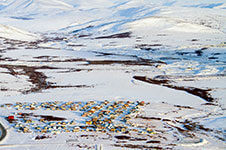With 66 days of polar darkness and below zero temperatures for almost half of the year, the reality of life in the North Slopes is harsh. For generations, the Iñupiat Alaska Natives have called this region their home. And while most villages have access to modern amenities, like grocery shopping, many people provide for their families and make a living by hunting or whaling.
Up until recent years, internet access was not a reality for villages in the North Slope. And the internet services these communities did have access to were incredibly unreliable. However, with recent advancements in telecommunications infrastructure, including Quintillion’s subsea and terrestrial fiber optic system and the HiLDA Ground Station in Utqiagvik, many towns are experiencing a digital transformation that is simultaneously exciting and overwhelming.
Bernice Oyagak is the Quintillion liaison for Utqiaġvik, formerly known as Barrow. It is the northernmost city in the U.S. With a population of approximately 5,000 people, it is the largest, most populated city in the North Slope Borough.
Bernice moved to Anchorage two years ago so she could better access medical services her family needs. Therefore, she has witnessed the digital transformation in Utqiagvik. Oyagak shared her thoughts on how these changes have affected her community.
“My aapa (grandpa) did not speak English, and the first time he saw a watermelon was when he was in his 50’s. When we talk about the digital divide, it’s like what is that? Digital? We’re not even there yet.”
While we know there is still much work to be done in Alaska to fully enable each and every community to access affordable, widespread broadband, enhanced internet services has already brought so much opportunity to Alaskans living in the North Slope.
How Has Better Broadband Services Helped Alaska Communities Grow?
The internet has become a vital service across the United States. Although the digital world is still very new to communities in Alaska’s North Slope, many rural Alaska communities have come to rely on the internet for work, school, entertainment, and medical services.
Younger generations have accepted this change the most readily and enthusiastically. Bernice used to work as a recruiter at Ilisaġvik, an Iñupiat tribal college that serves residents of the North Slope Borough. At every village high school she’d go to, most of the students wanted to be gamers.
“It’s starting to become a bigger deal, especially with the new technology that’s being offered. Our kids want to stay inside when it’s below 60 degrees, and they want to play games, use the oculus, and stream, and parents want to watch their favorite show on Netflix or football on the NFL app.”
Additionally, many older adults are utilizing the internet more frequently, especially for healthcare. In a community where there is very limited access to healthcare providers, many people have benefited from having the ability to access telemedicine services from their homes that may not have been able to access otherwise.
Better access to broadband has also helped advance utilities, including the underground water and sewage systems in Utqiaġvik. And many people living on the North Slope are seeking remote work outside their villages. Better broadband services enable them to access these opportunities.
What Issues Do Alaska Communities Face Without Reliable Internet Access?
Fiber internet is the gold standard for broadband infrastructure, and currently four out of eight villages in the North Slope Borough have fiber. While Utqiaġvik has benefitted from the increased speeds and reliability fiber optics brings, the remaining communities have been hit hard by access issues.
The biggest gap these communities face is in healthcare. The pandemic has brought a wide range of issues for northern Alaska communities. Because of the close-knit community events and households that support three to four generations of family members, the infection rate on the North Slope is incredibly high, and many communities are ill-equipped to support distance learning and remote work. And mental health issues are a serious concern. Bernice has witnessed the effects of drugs and alcohol and poor mental health in her community.
“’Education is the key to success’ is a quote by Eben Hopson, an advocate for the people of the North Slope in order to regain control of the education for the children. The North Slope Borough School District relies heavily on reliable internet access to be able to serve all eight villages. If the schools are closed due to an infection outbreak, the students rely on their home internet.
If they’ve reached their limit on data, the internet becomes unreliable, or they are forced to unplug from the connection to avoid overages. With a pandemic going on, the amount of people abusing drugs and alcohol has gone up increasingly, as have the suicide rates. And those who are wanting to get help are having to get transported out to larger cities, like Anchorage, because they don’t have access to telemedicine or telepsychology.
And that’s what some community members need. They need access to mental health services and professionals to be able to overcome the challenges of village life.”
What Challenges Make Accessing the Internet Difficult for Communities in the North Slope?
While access has increased immensely in recent years for many villages on the North Slope, many people struggle to afford the plans that are available. On the North Slope, the cost of living exceeds that of the national average. From milk to gas, consumers pay sometimes as much as double and triple the price for groceries and other necessities.
The internet service currently offered in the North Slope borough is incredibly expensive, with some plans costing as much as a mortgage. And these plans are capped — meaning users are allowed a limited amount of data. If they reach their capacity, the speed significantly decreases, and everything they see becomes pixelated. If they consume more than that amount, they are required to pay overages.
With that being said, many residents would not mind paying more for additional data, however, there are no providers on the slope that currently offer unlimited data plans. Residents of the North Slope do desire to have providers that do not impose data caps on their customers or raise those caps significantly.
Bernice explained that when the pandemic began, students were sent home to begin distance learning and it was quickly learned that households were not equipped to support the children.
“Most families were unable to afford the cost of being online for a full school day for all family members. This led to students taking home instructional packets and self-paced learning.
Some teachers went the extra mile and would record their lessons on a jump drive for each student and deliver them. Others would be made available only for a short period of time on Google Hangouts to support students who struggled. Some parents had to telework while providing assistance to their children to navigate and meet up with the required curriculum. It was an impossible task for many.”
For Alaska villages where there is already fiber, this expensive cost (paired with data caps) are the biggest hurdle that prevent more widespread adoption of internet services. While internet companies are seeking options to decrease these costs, and some governments are offering stipends and funding to help make internet service more affordable for end users, this continues to be a challenge in bridging the digital divide in Alaska.
Quintillion’s Ongoing Role in the Alaska Community
Quintillion is headquartered in Anchorage Alaska, and our passion for helping bridge the digital divide is the core of what we do. Our first goal was to build a terrestrial and subsea fiber optic cable system that has the capacity for internet providers in the North Slopes and other Alaska markets to provide high-speed, reliable service to the community.
We’ve seen countless benefits in the lives of Alaskans come from this project. For the communities that now have access to a fiber network, residents are able to access remote jobs, better utilize emergency response resources, use telehealth or teletherapy, and enjoy streaming platforms and online video games. With Quintillion’s recent broadband donation to the Ilisagvik College, the college has seen a 700% increase in the use of telemedicine and telepsychology.
There are still many steps necessary to help make even more digital resources available to Alaskans at an affordable price with unlimited usage capacity. We are excited to see numerous grants and funding opportunities becoming available to not only Alaska villages, but other communities across the United States as well.
We’re proud to continue supporting our Alaska community. Follow our journey to learn about our current projects.















